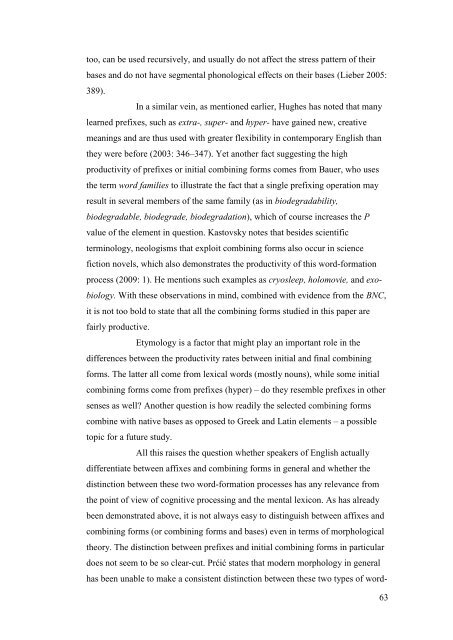The morphological productivity of selected ... - Helda - Helsinki.fi
The morphological productivity of selected ... - Helda - Helsinki.fi
The morphological productivity of selected ... - Helda - Helsinki.fi
You also want an ePaper? Increase the reach of your titles
YUMPU automatically turns print PDFs into web optimized ePapers that Google loves.
too, can be used recursively, and usually do not affect the stress pattern <strong>of</strong> their<br />
bases and do not have segmental phonological effects on their bases (Lieber 2005:<br />
389).<br />
In a similar vein, as mentioned earlier, Hughes has noted that many<br />
learned pre<strong>fi</strong>xes, such as extra-, super- and hyper- have gained new, creative<br />
meanings and are thus used with greater flexibility in contemporary English than<br />
they were before (2003: 346–347). Yet another fact suggesting the high<br />
<strong>productivity</strong> <strong>of</strong> pre<strong>fi</strong>xes or initial combining forms comes from Bauer, who uses<br />
the term word families to illustrate the fact that a single pre<strong>fi</strong>xing operation may<br />
result in several members <strong>of</strong> the same family (as in biodegradability,<br />
biodegradable, biodegrade, biodegradation), which <strong>of</strong> course increases the P<br />
value <strong>of</strong> the element in question. Kastovsky notes that besides scienti<strong>fi</strong>c<br />
terminology, neologisms that exploit combining forms also occur in science<br />
<strong>fi</strong>ction novels, which also demonstrates the <strong>productivity</strong> <strong>of</strong> this word-formation<br />
process (2009: 1). He mentions such examples as cryosleep, holomovie, and exobiology.<br />
With these observations in mind, combined with evidence from the BNC,<br />
it is not too bold to state that all the combining forms studied in this paper are<br />
fairly productive.<br />
Etymology is a factor that might play an important role in the<br />
differences between the <strong>productivity</strong> rates between initial and <strong>fi</strong>nal combining<br />
forms. <strong>The</strong> latter all come from lexical words (mostly nouns), while some initial<br />
combining forms come from pre<strong>fi</strong>xes (hyper) – do they resemble pre<strong>fi</strong>xes in other<br />
senses as well? Another question is how readily the <strong>selected</strong> combining forms<br />
combine with native bases as opposed to Greek and Latin elements – a possible<br />
topic for a future study.<br />
All this raises the question whether speakers <strong>of</strong> English actually<br />
differentiate between af<strong>fi</strong>xes and combining forms in general and whether the<br />
distinction between these two word-formation processes has any relevance from<br />
the point <strong>of</strong> view <strong>of</strong> cognitive processing and the mental lexicon. As has already<br />
been demonstrated above, it is not always easy to distinguish between af<strong>fi</strong>xes and<br />
combining forms (or combining forms and bases) even in terms <strong>of</strong> <strong>morphological</strong><br />
theory. <strong>The</strong> distinction between pre<strong>fi</strong>xes and initial combining forms in particular<br />
does not seem to be so clear-cut. Prćić states that modern morphology in general<br />
has been unable to make a consistent distinction between these two types <strong>of</strong> word-<br />
63
















